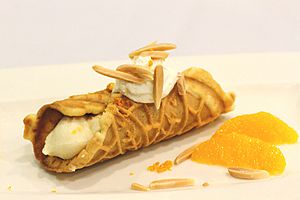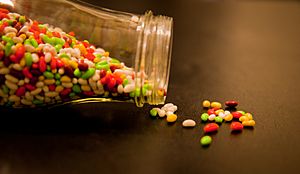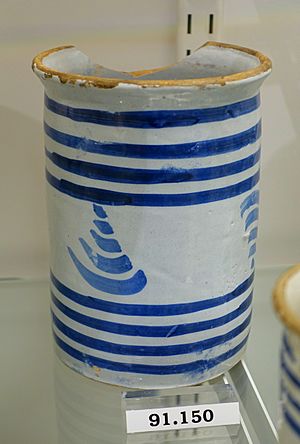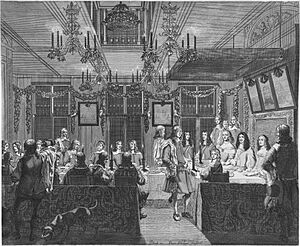Confectionery in the English Renaissance facts for kids

During the English Renaissance (roughly 1485-1603), people enjoyed many kinds of sweet treats. These treats were mostly made with sugar. Sugar was quite new and special at that time. Many people even thought these sweets had healing powers. This idea came from Arabic cultures, where sugar was used as medicine.
In the mid-1500s, sugar became much cheaper and easier to find. This happened because European countries started colonizing new lands in the Americas. Sugar then began to be used more for flavor, preserving food, and making things sweet, just like it is today. It was less often seen as a medicine.
Contents
How Sweet Treats Began
Before the Renaissance, sweet treats were often fancy imports from places like the Mediterranean and the Middle East. These included things like almonds, citrus fruits, rosewater, spices, and sometimes sugar. Because these ingredients were rare and costly, making sweets was a respected skill.
Even though sugarcane was known in Europe since Roman times, people usually preferred honey for sweetness. Sugar became more popular after Arabs and Persians figured out how to make refined sugar.
Italian traders helped bring sugar and other sweets from the Middle East to Europe, especially during the Middle Ages. The city of Venice was a very important trading center. It helped spread Arabic knowledge about sugar and medicine. Sugar became more common in Europe around the 1420s. This was when Portuguese colonies started growing sugarcane and sending it to Europe.
The price of sugar dropped a lot in the mid-1500s. This happened when sugar from the "New World" (the Americas) became widely available. This meant more sweet treats could be made. Confectioners (people who made sweets) could now sell to more people, not just the very rich. At first, sugar was linked to medicine. But in the early Renaissance, it became popular as a main ingredient in sweets and for preserving food. Noblewomen (rich ladies) even started making sweets as a hobby. This helped start the tradition of fancy banquets in England.
Sugar and Colonies
Renaissance sweets relied heavily on sugar. The colonization of the Americas greatly changed the sugar trade by the mid-1500s. Spanish colonies in the Canary Islands and Portuguese colonies in the Azores, Madeira, and São Tomé were the first to use enslaved people to produce sugar.
The West Indies soon became ideal for growing sugarcane. From the early 1500s, colonizing countries forced Africans to work as slaves on sugarcane plantations there. The Atlantic slave trade brought many enslaved people to fuel sugar production and imports into England. This system continued for centuries.
Working on sugar plantations was extremely hard. Enslaved people had to dig pits for planting sugarcane, then harvest it, and crush it in sugar mills. Sugarcane was a crop that needed much more labor than other crops like cotton. The sugar slave trade was a massive system of forced labor.
Kinds of Sweet Treats
Sweetmeats
"Sweetmeats" was a general term for many kinds of sweets made with sugar.
Quince was a very popular fruit in the Renaissance. It was used for medicines and eaten preserved, as jelly, or as the main ingredient in marmalades. Marmalade back then was a thick quince paste cooked with sugar. Sometimes, it had rosewater, spices, or fruit juices added. It was often shaped in fancy molds and served with small candies called comfits on top.
Syrups were sugar-based sweets made by boiling sugar and water. They could be served alone or with candied fruits. Syrups became popular for preserving fruit among common people when sugar prices dropped. Before that, rich women made them at home. The idea of using syrup to preserve fruit came from Arabic countries. England learned about it by importing preserved citrus fruits.
Conserves were made by crushing fresh herbs, flowers, or fruits with sugar to make a thick, sticky mix. They were often made with fragrant flowers and could have medicinal ingredients. Popular conserves included those made from red roses, marigolds, violets, and oranges.
Biscuits were found at royal banquets and in homes. Their name means "twice-cooked." This refers to how they were baked to make them crispy. Another way to make them was to boil the dough in sugar syrup, which gave them a different texture. Biscuits were shaped into letters or knots and often served at court.
Marchpane was made from almond paste, rosewater, and powdered sugar. It was easy to mold into any shape. Wafers were made by cooking batter between patterned irons. They could be rolled into a cone and filled with something sweet. They were sometimes flavored with orange blossom water or coffee.
Comfits
A comfit was a spice, seed, or nut coated with sugar. It was one of the first sweet treats. Comfits started in the Middle East as a medicine for indigestion. They came to Europe through Italian merchants. Comfits were a main specialty of confectioners in Renaissance England. They were also sold in apothecaries (old pharmacies).
To make a comfit, confectioners used a special pan. They would lay out the food to be covered and then coat it with gum arabic. This stopped oils from messing up the sugar coat. Then, many layers of sugar syrup were added. The comfits were dried in the sun. The last layers often had a color added, like saffron or beet juice. The sugar syrup itself could also be flavored with musk, ambergris, or rosewater.
There were two main types of comfits: smooth and ragged. They had different textures because of how thick the sugar syrup was. Long comfits, which were thin pieces of cinnamon or orange, were used a lot for decoration. The most popular comfits were coated caraway seeds, aniseed, fennel seeds, coriander seeds, and almonds.
Health and Medicine
Sugar first came to Europe as a way to preserve food and as a medicine. European apothecaries learned many of their methods from Arabic doctors.
Renaissance medicine partly focused on diet. Doctors suggested eating sugar to prevent bad effects from other foods. Certain foods were thought to have special properties. A food's value was judged by its taste and how it supposedly affected the body. For example, sugar was called "hot and moist," which was thought to be good for the human body. This made sugar seem like a "miracle food." It was used a lot in court feasts and praised for its healing value.
The Apothecary
The Renaissance apothecary was a shop that sold medicines. Sometimes, they even prescribed them. Medicines were made based on the idea of the four humors (body fluids). Apothecaries often made personalized medicines for each person.
The apothecary was the main seller of sugar-based mixtures. This changed later in the Renaissance when confectioners started selling sugar as food. Typical products included syrups, preserved herbs and roots, floral sugars, lozenges, and comfits. Sugar was used to preserve and flavor medicines that tasted bad. It also helped carry medicines, like in special marmalades.
Examples of Medicines
Sticks of pulled sugar called al fänäd were used in the Middle East for coughs and fevers. English apothecaries often sold these as alphenics (like early cough drops). Cordial waters were alcoholic drinks thought to cure many illnesses. Sweet foods were often prescribed for chest problems.
Floral sugars, flavored with violets and roses, came from the Middle East. They were said to cure coughs. Similarly, preserved flowers and herbs were used for many ailments. Simple quince marmalade was often a base for medicines. One medicine for "Diseases of the Head" was called Marmelada Cephalica. It was thought to cure things like fits and epilepsy. Besides quince, it contained salt from a human skull, amber, and mace.
After a banquet, people often ate caraway and aniseed comfits, quince marmalades, spiced waters, and cordials. These were meant to help with indigestion after eating too much.
Medicines were not only made in apothecaries. Many recipe books existed for home use, mainly by rich ladies. A common home preparation was syrup. In medicine, syrups were used to make the healing properties of a food stronger. They also made bitter medicines taste better and carried other healing substances. Syrups could be made from various flowers, fruits, spices, and herbs. Their main use was to "soothe an inflamed organ" and make weak people stronger. Different syrups helped with different problems. The two most common syrups were made of violets (for lowering a fever) and roses (for calming anger).
The Banquet
The English sweet banquet was an early version of today's dessert course. It had sweet treats, spiced drinks, and fancy sugar sculptures. It was served after the main meal. It grew from the medieval "void," which was a small snack served after the table was cleared. It was also influenced by the Italian collazione, a grand display of sweets and sugar art.
A banquet was a performance as well as a meal. It started in royal courts in the early 1500s. It quickly became a way for English nobles to show off their status. Banquets were often held when important guests were present. Confectioners and hosts put a lot of effort into decorating and presenting the food.
Fruit purees like apricots, cherries, and gooseberries were boiled with sugar. Then, they were poured into detailed molds. Once set, confectioners would make knots, words, or fake fruits from the stiff marmalade for decoration. Sugar syrups were hardened into sculptures, sometimes showing historical or mythical figures. These were mostly for looking at, not always for eating.
Jumbals, which were "intricately knotted biscuits" from Italy, were shaped into letters. These letters could spell out topics the host wanted to discuss. Making things look different from how they tasted was an important part of the presentation. Sometimes, confectioners would purposely make foods to "trick" the diner. Recipe books from that time show how to make, for example, a fake ham from sugar, berries, and flowers. They also show how to make artichokes and asparagus from marzipan, and even "objects, such as coats of arms."
Sweetmeats often served at banquets included fruits preserved in sugar syrup, marmalades, molded fruit pastes, comfits, conserves, and biscuits. Quince marmalade was common at Elizabethan-era banquets. It was served with other preserves. A common practice after a meal was to "seal" or settle the stomach with quince marmalade. Comfits and cordial waters served a similar purpose. They were eaten to help with the effects of eating too much.
In Books and Plays
Banquets often appear in William Shakespeare's plays. In The Tempest, a character named Ariel makes a banquet appear and disappear to tease shipwrecked sailors. This scene shows how courtly culture could sometimes go against ideals of friendly gatherings. Romeo and Juliet also shows a banquet scene in Act 1, Scene 5. The character Capulet acts as if the banquet is not very important. Critics say that banquet scenes like these show the difference between the servants who set up the banquet and the nobles who feast at it.
John Webster's play The Duchess of Malfi includes a scene where the main character's last words are "giv'st my little boy/ Some syrup for his cold." This has been seen as her changing from a "disobedient wife" to a "tender mother." Some scholars focus on syrup as a symbol of home life. They connect it to noblewomen often making medicines at home.
|






